#nath nose ring
Explore tagged Tumblr posts
Text
#nose ring#nose pin#nath#nose pin for women#ladies nose pin#nip rings#nath nose ring#nath online#artificial nath#nose pin price#nose piercing#diamond nose pin
0 notes
Text

#Nose Pin#Jadau Nose Pin#Nose rings#jadau Nose Ring#Nose Ring Designs#Jadau Nath#Kundan Nose Pin#nose pin online#Indian nose pin#press on Nath#gold press nath#Nose pin with pearl#nath nose ring
1 note
·
View note
Text
I WANT TO BUY A NATH
#but i alr wear a gold nose ring and i cant remove it rn but the naths are so so so pretty#even if they cost an arm and a leg#like wdym its 120₹ for a NATH?!
5 notes
·
View notes
Text
Bridal Nose Ring Nath: Essential Tips for First-Time Wearers

The bridal nose ring, commonly known as the "nath," holds immense cultural and symbolic value in many South Asian weddings, particularly in India. Beyond being a statement piece of jewelry, the nath is often regarded as a sign of a bride’s beauty, grace, and familial tradition. For first-time wearers, adorning a nath can be a mix of excitement and apprehension. From selecting the right design to dealing with practical concerns, wearing a bridal nose ring comes with its own set of considerations. If you're about to wear a nath for the first time, this guide will help you navigate everything from choosing the perfect style to tips for comfort.
1. Understanding the Symbolism of the Bridal Nath
Before diving into the practicalities, it’s important to understand the cultural significance of the bridal nath. In many Indian traditions, the nose ring is more than just an ornament—it symbolizes marital status, much like the mangalsutra. In certain cultures, a woman may only wear the nath on her wedding day or special occasions like festivals. In regions like Maharashtra, Punjab, and Rajasthan, the nath plays a key role in bridal attire and is often passed down through generations, signifying continuity of tradition.
2. Types of Bridal Nose Rings (Nath)
There are a variety of styles and designs available for bridal naths, depending on the region, culture, and the bride’s personal taste. Here are some of the most popular styles:
Maharashtrian Nath: Typically adorned with pearls and a single stone, the Maharashtrian nath is crescent-shaped and sits on the left nostril. It has a distinct, traditional design that holds significance in Maharashtrian weddings.
Punjabi Nath: This is a large, circular nose ring, often decorated with intricate designs and connected to the bride's hair or ear via a delicate chain. Punjabi brides typically wear these naths as a grand statement piece.
Rajasthani Nath: Known for its size and elaborate design, the Rajasthani nath is often large and opulent, made with gold and adorned with precious stones like diamonds, rubies, and pearls.
South Indian Nath: More delicate and minimalistic, the South Indian nath often features tiny floral patterns and is commonly adorned with diamonds or small gold designs.
Modern Nath: With changing trends, many brides opt for modern naths, which combine traditional designs with contemporary aesthetics. These designs are often more minimal and lightweight, making them easier to wear for extended periods.
3. Choosing the Right Nath for Your Face Shape
When it comes to selecting a bridal nath, your face shape plays a crucial role. Here are some tips on choosing a nath that complements your facial features:
Round Face: If you have a round face, avoid large, round naths as they may make your face appear fuller. Opt for long, slender designs that create an illusion of length and slimness.
Oval Face: An oval face is versatile, and most nath designs suit this shape. You can experiment with a variety of styles, whether they are small and delicate or large and intricate.
Square Face: Brides with square faces should opt for rounded designs that soften the angles of the face. A circular or hoop-style nath will balance the sharpness of the jawline.
Heart-Shaped Face: If you have a heart-shaped face, try to balance your features by opting for slightly larger naths that add volume near the chin and jawline.
Ultimately, the design you choose should not only suit your face but also your personal style and comfort level.
4. Pierced vs. Non-Pierced Naths
For brides who have never worn a nose ring before, the question of whether to get a piercing or opt for a clip-on nath is important.
Pierced Nath: If you already have a nose piercing or plan to get one, a pierced nath offers a secure and comfortable fit. However, getting a piercing solely for your wedding day may not be ideal if you aren’t used to wearing nose rings regularly. Keep in mind that a new piercing requires at least six to eight weeks of healing time before you can safely wear heavy jewelry.
Non-Pierced Nath: Many brides opt for non-pierced naths that come with a clip-on mechanism. These naths can be equally stunning and are perfect for those who don’t wish to commit to a piercing. Just ensure that the clip-on mechanism is comfortable and secure to prevent any slippage during the ceremony.
5. Balancing Comfort and Style
Wearing a nath can sometimes be uncomfortable, especially if it’s a large or heavy design. If you're new to wearing nose rings, here are some tips to ensure maximum comfort:
Test Before the Wedding: If you’ve chosen a clip-on nath, try wearing it for a few hours before your big day to get used to the sensation. This will help you adjust to any discomfort and ensure the fit is secure.
Use a Lightweight Chain: Many larger naths are attached to the hair or ear with a thin chain, which distributes the weight of the jewelry and reduces pressure on the nostril. If your nath doesn’t come with a chain, consider adding one for extra support.
Go for Lighter Materials: If you're not used to heavy jewelry, consider opting for a nath made of lightweight materials like thin gold or silver. Heavy naths, though grand, can cause discomfort over time.
6. Coordinating Your Nath with Other Bridal Jewelry
A nath is just one part of the larger ensemble of bridal jewelry, and it’s essential to coordinate it with other pieces like the maang tikka, earrings, and necklace. Here’s how to achieve a balanced look:
Harmonize Metals: Make sure the metal of your nath complements the rest of your jewelry. For example, if your bridal set is gold, opt for a gold nath to maintain uniformity.
Complement Stones: If your bridal jewelry includes colored stones like rubies, emeralds, or diamonds, choose a nath that features similar gemstones to tie the whole look together.
Keep Proportions in Mind: If your maang tikka and earrings are large and elaborate, opt for a smaller, delicate nath to avoid overwhelming your face. On the other hand, if your other jewelry is subtle, you can go for a larger, statement-making nath.
7. Piercing Aftercare for Brides
If you’ve decided to get a nose piercing before your wedding, proper aftercare is essential to ensure it heals properly before the big day. Here are some aftercare tips:
Clean Regularly: Clean your piercing twice a day with a saline solution or a mixture of sea salt and warm water to prevent infection.
Avoid Touching: Try not to touch or twist the nose ring frequently as this can introduce bacteria and delay the healing process.
Be Patient: Allow your piercing the full recommended healing time (6-8 weeks) before switching to heavier jewelry, like a bridal nath, to avoid irritation.
8. Practical Considerations for the Big Day
Finally, here are a few practical tips to keep in mind when wearing a nath on your wedding day:
Secure It Well: Ensure that your nath is secured properly, especially if it’s a clip-on. The last thing you want is for it to slip or move during the ceremony.
Carry an Emergency Kit: Ask your bridesmaids or family members to carry a small emergency kit with extra bobby pins, a small mirror, and any necessary tools to adjust your nath if needed.
Practice Wearing It: Don’t wait until your wedding day to wear your nath for the first time. Practice wearing it during your dress fittings or makeup trials to get used to the feel and weight.
Conclusion
The bridal nose ring, or nath, is an exquisite piece of jewelry that adds elegance and cultural depth to a bride’s wedding attire. While it may seem daunting to wear a nath for the first time, following these tips will help you choose the right design, ensure comfort, and coordinate it with your overall bridal look. Whether you opt for a traditional or modern style, your nath will be a beautiful symbol of your new journey as a bride.
0 notes
Text

Grab The Look Of Model Influencer in Full Rajputi attire and Jewellery for upcoming Rakhi, Teej and Sawan occasion
Courtesy :—
In frame : @sonam_thakur1998
Dress Designer: @poshak_by_jaishri
To shop visit our website www.sonkanch.com or walk in store or DM@9351511707
⭐Certified for gold and silver purity by leading laboratories.
⭐Guarantee on Back Silver Cover Gold Plating.
⭐100% Exchange of Full Bill Amount after 3 years
⭐️ Free Shipping All Over India
#jewellery #jewellerystore #jewelleryshop #viral #jewellerylove #handmadejewellery #designerjewellery #jewellerydesigner #stylishjewellery #indianjewelry #bollywoodjewellery #traditionaljewelry #wholesalejewelry #jewelrylovers #rajputana #rajputijewellery #royaljewels #royaljewellery #rajasthan #thewajewellery #rakhi #teej #wedding #indianbride #indianwedding #trending
http://www.sonkanch.com
#thewajewellery#thewajewelry#rajputijewellery#goldjewellery#thewaartjewellerypratapgarh#thewaart#jewellery#indianjewellery#silverjewelry#jaipur#rakhdi#borlas#nath#nosepin#nose jewelry#nose ring#nosering#hasli
0 notes
Text

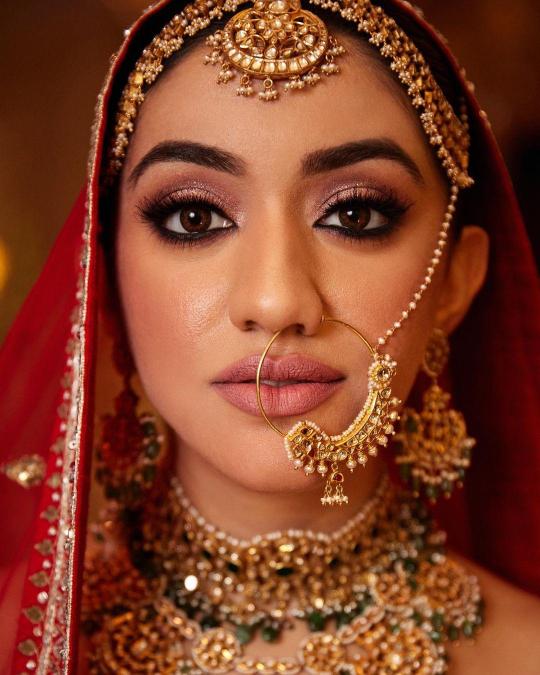


Check Out The Most Stunning Nath Designs For Brides This Wedding Season
#best nose rings#Bridal Jewellery#Bridal Nath#bridal nose jewellery#bridal nose rings#Bridal Trousseau#Gold Jewellery#heavy bridal nath#heavy jewellery#nath designs#nose ring designs#nose rings#ott nath designs#pearl drop nath#pearl jewellery#small nath#vintage nath design#Wedding Jewellery#shaadiwish
0 notes
Text
Explore the rich history and cultural significance of Indian nose rings
The History and Significance of Indian Nose Rings: A Buyer's Guide

Introduction:
Nose rings, also known as "Nath" in India, have been an integral part of Indian culture and tradition for centuries. These exquisite pieces of jewellery hold deep historical and cultural significance and have transcended time, evolving from a symbol of femininity and marital status to a fashion statement embraced by people around the world. In this comprehensive buyer's guide, we will explore the rich history, cultural significance, and various styles of Indian nose rings, empowering you to make an informed and meaningful purchase.
Historical Origins of Indian nose rings:

The tradition of wearing nose rings in India can be traced back to ancient times. References to nose rings can be found in the Vedas, the sacred texts of Hinduism, dating back over 3,000 years. Initially, nose rings were worn as a symbol of wealth and status, with larger nose rings made of precious metals and adorned with gemstones being reserved for royalty and aristocrats.
Symbolism and Cultural Significance:
Indian nose rings carry various symbolic meanings across different regions and communities. In some parts of India, nose rings are worn as a sign of marital status. Married women often wear them as a symbol of their union and commitment to their husbands. In certain cultures, nose rings are believed to enhance a woman's beauty and highlight her femininity.
Moreover, nose rings also hold spiritual and Ayurvedic significance. The left nostril is considered the spot associated with a woman's reproductive organs, and wearing a nose ring on the left nostril is believed to ease childbirth and menstrual discomfort.
Variety of Styles in Indian nose rings designs:
Indian nose rings come in an array of styles, each reflecting the unique cultural heritage and craftsmanship of different regions in India. Some of the popular styles include:
1. Phul: The "phul" nose ring is characterized by its floral design, often inspired by nature. It is typically worn on the left nostril and is a common choice for brides, symbolizing new beginnings and fertility.

2. Laung: The "laung" is a smaller nose ring typically worn on the right nostril. It is shaped like a clove bud and is commonly worn by both married and unmarried women as a fashion accessory.
3. Nose pin or Nath: The traditional "Nath" is characterized by an intricate design, often adorned with pearls, beads, and delicate metalwork. It typically features a chain that connects the nose ring to the hair, adding an extra element of grace and beauty.

4. Septum Ring: While nose rings are commonly worn on the nostrils, septum rings are gaining popularity. Known as "Nathani" or "bullaku" in some regions, these rings are inserted into the septum, creating a unique and edgy look.
Materials and Craftsmanship:
Indian nose rings are crafted from a variety of materials, ranging from traditional metals like gold and silver to more contemporary options like stainless steel and artificial alloys. The craftsmanship involved in creating these intricate pieces is awe-inspiring, with skilled artisans employing techniques passed down through generations.
Modern Trends and Global Appeal:
In recent years, Indian nose rings have transcended cultural boundaries and gained popularity in the global fashion scene. Celebrities and fashion influencers have embraced this beautiful piece of jewellery, incorporating it into their style in various ways. Nose rings are now available in a wide range of designs and materials, making them accessible to people worldwide.
Buying Guide:
When you are going to buy nose rings online, there are several factors to consider:
1. Material: Choose a material that suits your style, budget, and sensitivity to metals. Gold and silver are classic choices, while stainless steel and artificial alloys offer more affordable options.
2. Design and Style: Consider the occasion and your personal taste. Traditional naths are ideal for weddings and cultural events, while simpler designs like laung or septum rings are perfect for daily wear.
3. Fit and Comfort: Ensure that the nose ring fits comfortably and securely, without causing irritation or discomfort.
4. Authenticity and Source: If purchasing precious metals or gemstones, ensure the authenticity and source of the materials. Buy from reputable sellers and certified jewellers.
5. Maintenance and Care: Learn about the care and maintenance required for the nose ring to keep it in pristine condition.
Conclusion:
Indian nose rings are more than just jewellery; they are a living testament to India's rich cultural heritage and traditions. From the historical significance to the stunning craftsmanship and evolving fashion trends, each aspect adds a unique allure to these exquisite pieces. By understanding the history and cultural significance of Indian nose rings, you can make a meaningful and stylish addition to your jewellery collection, cherishing the beauty and legacy of this timeless adornment.
0 notes
Text
a question about nose rings in South Asia:
19th-century writing in English that references the nath often connects the nose-ring worn by, at that time, only married women, to the nose piercings given to animals (and, they claim, slaves)—i.e. it's a sign of the absolute subjection of a woman to her husband.
I get the sense that this is one of those weird fantasties that white people like to insist are fact. but in a South Asian context—say, in an older generation when nose studs and rings were worn exclusively by married women to the exclusion of single women and widows—is there any world in which a woman who otherwise wears women's clothing would refuse to wear a nath on the basis of finding it degrading?
or is there just no connection at all between this item of jewellery + the contexts in which it is worn, on the one hand, and a concept of ownership, on the other?
26 notes
·
View notes
Text
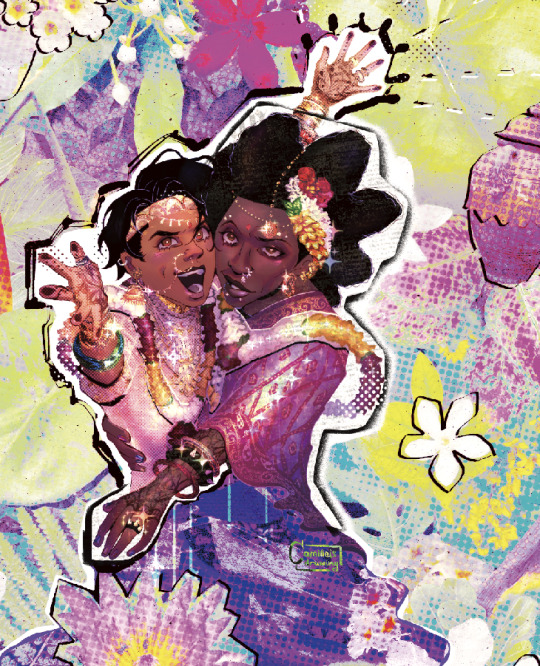
they might be married a bit
[ID: Pavitr is wearing an eggshell-colour kurta pajama, a nath/nose hoop, many necklaces, and other shiny jewellery including the ring on his left ring finger, his hands up like a dance pose, his smile wide and proud. Their faces beside each other, Hobie hugs his waist, showing the audience a spiky ring on his left ring finger. Hobie is wearing an embellished deep red sari, bindi, nose ring and multiple bracelets. He has fresh flowers in his hair. Both of them wear henna on their hands and arms. Hobie's resembles spider webs or his torn fishnets, Pavitr's lotuses in full bloom. They also wear floral garlands on their neck. They look like a paper cut-out on a lime-green, cyan, magenta and violet halftone collage background, which consists of various leaves and flowers and a terracotta vase. Fern, lotus and gardenia just to name a few. Photos are taken from our garden.]
#camilleisdrawing#digital art#digital illustration#digital painting#collage#spiderverse#across the spider verse fanart#across the spiderverse#atsv#hobie brown#pavitr prabhakar#spiderverse fanart#pavpunk#goldenpunk#hobie x pavitr#traditional clothing#digital collage
393 notes
·
View notes
Text
The Story of Solah Shringar
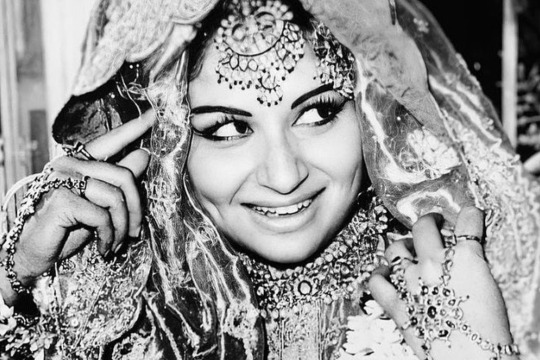
The Indian bride is the epitome of grace, elegance, and beauty. Her attire and traditional Indian bridal jewelry catch every eye and leave a lasting impression on everyone. While her wedding outfit accentuates her best features, her Indian bridal jewelry adds a subtle shine and a touch of sophistication to her entire look.
As per tradition, the Indian bride embellishes herself with 16 adornments on her wedding day. These adornments are called Solah Shringar. This ritual has been practiced since ancient times and is an integral part of bridal preparations.
The story behind the Solah Shringar features Rati, the wife of Kamdev, the Hindu god of love. Rati engaged in severe penance to appease Goddess Lakshmi. She was then blessed with the 16 adornments from Lakshmi and wore them to impress and marry Kamdev.

16 adornments (16 sringar)are
1. Sindoor
The first adornment is Sindoor, also known as kumkum or vermillion. Sindoor holds a special place as it marks the beginning of a woman’s new journey as a bride. Sindoor is applied by the groom on the forehead between the hair partition of the bride. The bride then continues to wear sindoor throughout her married life.
2. Hair care (Kesh Sringar):
We now focus on the ‘Kesh’, or hair. The Indian bride embellishes her hair using fragrant flowers and glittering headpieces. Traditionally, the bride made three braids that represented three holy rivers, Ganga, Yamuna, and Saraswati, and the trinity of the Hindu gods Brahma, Vishnu, and Mahesh. The fragrance of flowers keeps the bride fresh throughout the day and her Indian bridal jewelry embellishes her hairdo, adding another layer of elegance and beauty to her overall look.
3. Maangtika
The part of the forehead where the maangtika rests is believed to be the home of Ajna Chakra or the third eye. When the bride wears the piece of Indian bridal jewelry on her special day, she is believed to be connected with her third eye and has the ability to control her emotions and activate her knowledge, wisdom, courage, and willpower.
4. Bindi
The bindi also takes us to the third eye. Bindi comes from the Sanskrit word bindu, which means ‘point’ or ‘dot’. The bindi is closely associated with improving concentration and retaining energy. It is one of the most popular adornments worn by the Indian bride and is known internationally.

5.Kohl or Kajal
From the forehead, we move to the eyes. Kohl, kajal, surma, kanmashi, kaadige, kaatuka, and kan mai are some names for one of the oldest natural beauty products in the world. Kajal accentuates the eyes of the bride and is believed to ward off the evil eye in various cultures. The darkening around the eyes also protects the wearer from the harsh rays of the sun.
Kajal is an essential element of the solah shringar and makes the eyes look more prominent. It is undoubtedly a beautiful way to enhance the natural beauty of the bride.
6 .Karn Phool or Earrings
A wedding day look cannot be completed without a set of dangling earrings. Karn Phool is a Sanskrit term that translates to ‘flower of the ears’ and is an essential part of the solah shringar.
7 .Nath(nose ring)
The nose ring is another beautiful element of the Indian bride’s attire and is a symbol of valor, fertility, and spirituality. The large nose rings hooked onto the hair with a chain take the bride a step closer to creating her ideal look. It is one of the most ethnic elements of Indian bridal jewelry and a wedding day look is surely incomplete without it.
8 .Haar or Necklace
The one thing that brings the whole look together is the necklace. Necklaces are said to represent safety and abundance and are believed to help the wearer control their emotions better. Some necklaces feature specific motifs or gemstones that are believed to bring good luck and ward off evil spirits.
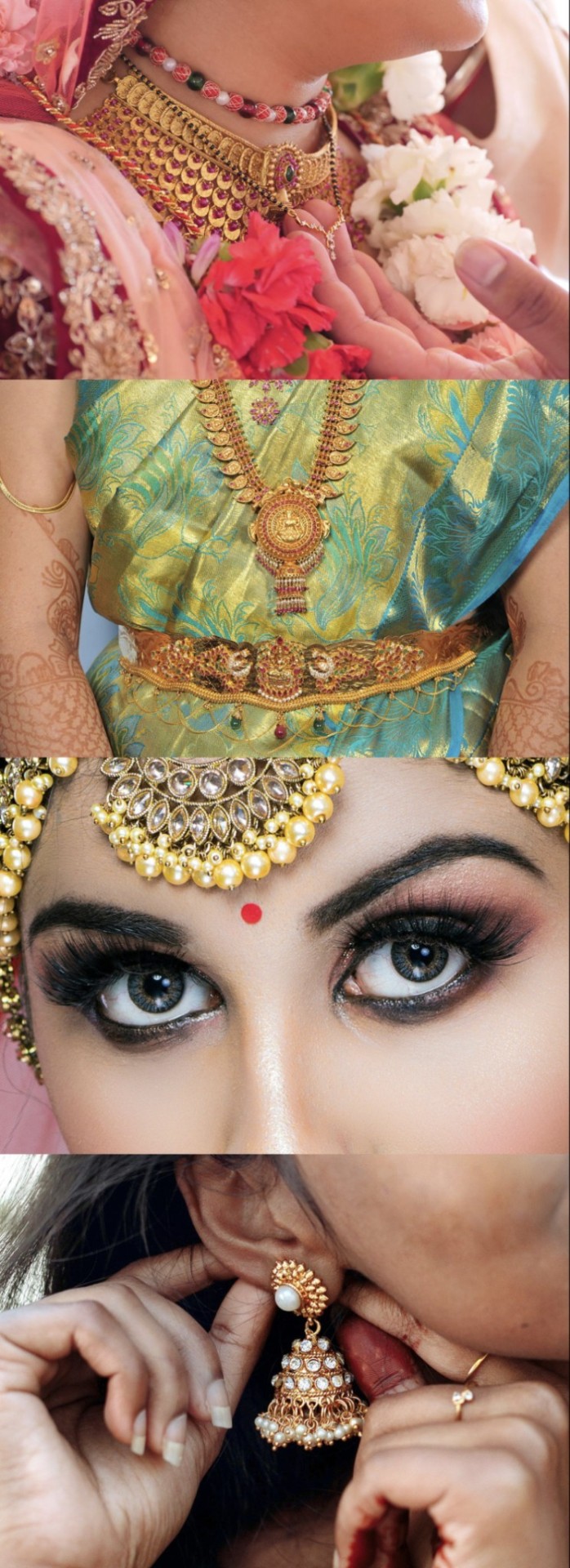
9 .Bajuband
This element of traditional Indian bridal jewelry is worn on the upper arm. The bajuband is believed to keep evil spirits away and protects the wearer. The Indian bride can embellish her wedding outfit with all sorts of armbands that are encrusted with diamonds and other colorful gemstones.
10 .Bangles, Bracelets, Choodiyan
Bangles and the Indian bride are inseparable. They’re a part of traditional Indian bridal jewelry that a woman always wears. It is believed that bangles and bracelets bring health, luck, and prosperity to the wearer and are more than a jewelry item or accessory for the traditional Indian woman. There are various wedding ceremonies related to bangles and bracelets across cultures that show us their significance in Indian culture.
11 .Hathphool and Aarsi
The hathphool is a clever mix of a bangle and a ring. Bringing the best of both together, this element of traditional Indian bridal jewelry embellishes the hand and wrist of the bride. The interesting crossover of the two pieces surely adds more flavor to the wedding day look.
A thumb ring known as Aarsi is also worn by some brides. Aarsi contains a small mirror. This mirror allows the bride to catch a glimpse of the groom since she is covered in a veil and cannot see the groom’s face.
12 . Mehndi
Henna, commonly known as mehndi, is undoubtedly one of the most amusing parts of a traditional Indian wedding. It is believed that mehndi brings good luck and joy to the bride. The darkness of the mehndi represents the strength of the bond between the bride and the groom. The solah shringar of the bride is incomplete without her hands and feet embellished with beautiful mehndi designs that add to her overall wedding day look.

13 . Kamarband (waist band)
The use of the kamarband, or waistband, is scarce in North Indian weddings but it is an important part of a South Indian bride’s trousseau. The piece of Indian bridal jewelry is adorned with gemstones and is used to accentuate the female’s body and keep her bridal saree in place.
14 . Anklets and Toe Rings
Commonly known as payal and bichhu, these elements of traditional Indian bridal jewelry embellish the feet of the bride. Payals can be recognized by the beautiful chime sounds they make whenever the bride walks. Toe rings are seen as a sign of marriage and a bride wears them until the death of her husband.
15 . Itar
Itar is the perfume that a bride applies to freshen her aura and stay fragrant throughout her special day.
16. Wedding Outfit
Finally, the one thing that clubs every element together and brings the bride’s imagination to life is the wedding outfit. The traditional Indian bride wore the classic red wedding outfit but with the evolution of Indian weddings, other colors have started to take center stage as well.
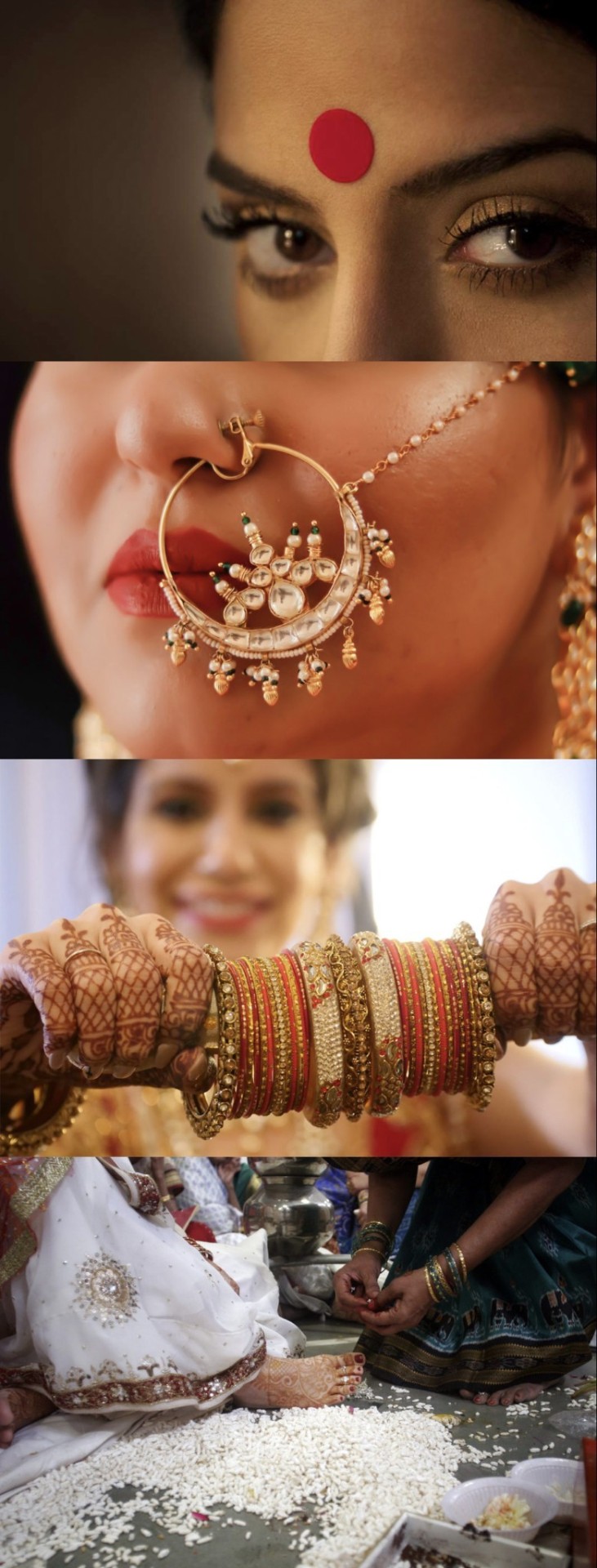
Source
#desiblr#16 adornments#16 sringar#desi girl#desi tumblr#being desi#desi tag#desi aesthetic#desi academia#desi#indian girl#indian wedding#indian culture#hindublr#hinduism#chakras#desi culture#beauty
36 notes
·
View notes
Text
Nose rings in Egypt
Wearing nose rings in the Eastern Mediterranean actually goes back to the time that the Torah was being written. Referred to as nezemim, Rebecca is noted as wearing one. The practice continues to this day, though they are less common and have grown to be more strongly associated with South Asia and Alt sub cultures. Today it is thought that the wearing of nose rings in India may have been imported from West Asia (the assertion that they were brought over by the Mughals seems inaccurate, however, as the first mention of them is from around 1000 AD)- the discussion is somewhat contentious and unfortunately often feeds into political violence and bias against Muslims when mentioned.
The earliest modern depuction of a nose ring being worn in Egypt comes from the 1830s, thanks to our old enemy and research dog, Edward William Lane. He describes then as being made of brass or occasionally gold with glass beads attached to them, an inch to an inch and a half in diameter, says they are worn on the right side of the nose. His account associates them with poor women. He records the name as "khizám" or "khuzám".
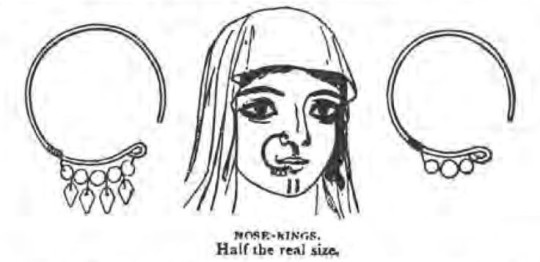
A difficulty comes in recognizing nose ring examples held in museums; I have found a few items resembling this style, but they are described as earrings. The V&A is responsible for two cases, and given they have gotten information wrong on both Ancient and Modern Egyptian jewelry, my suspicion is these examples may be misidentified. The two examples will be shown promptly.
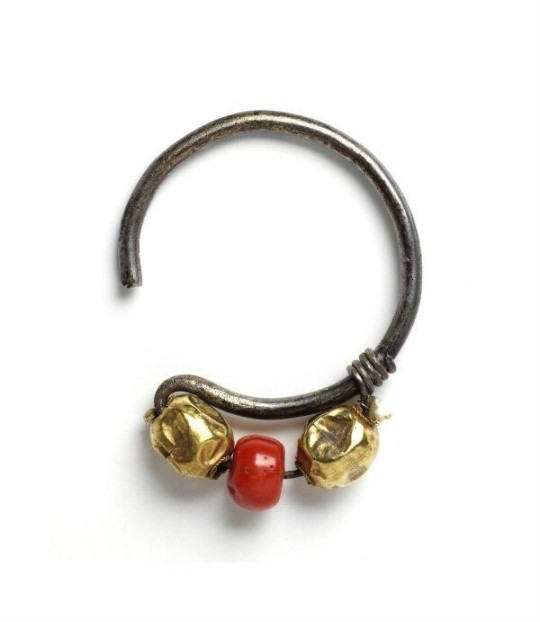
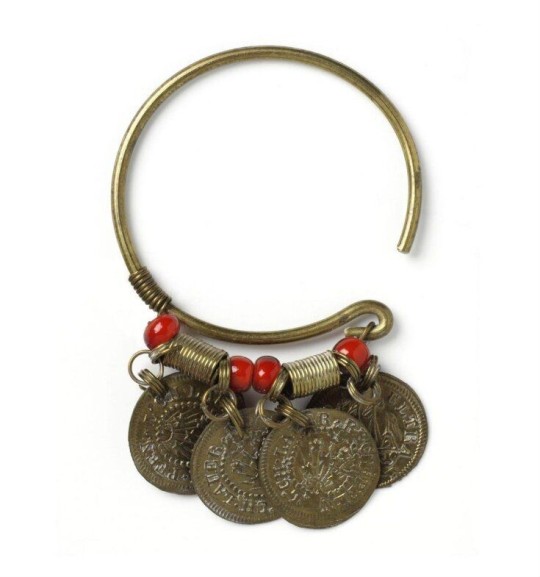
Another example of dubious identification comes from a design that may be multipurpose; silver rings with an openwork barrel at one end. The TRC Leiden institute has an example from Saudi Arabia and claims its a nose ring, but it bears close resemblance to some Egyptian examples identified as earrings, and those resemble some Coptic bronze examples also identified as earrings. To my mind this style also resembles Amazigh earrings/head ornaments (these were sometimes attached to the headdress, not the ears themselves). It is also possible that TRC Leiden has misidentified the item.
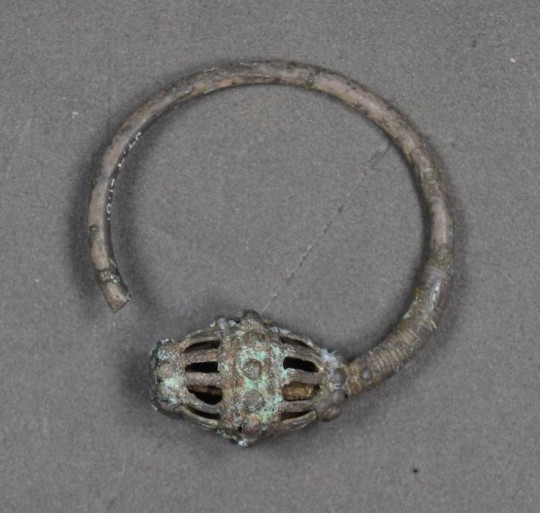
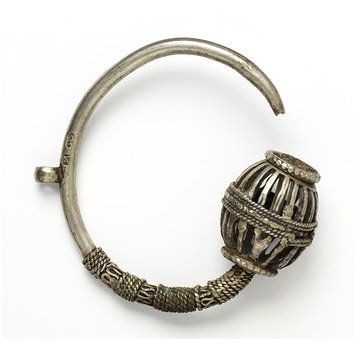
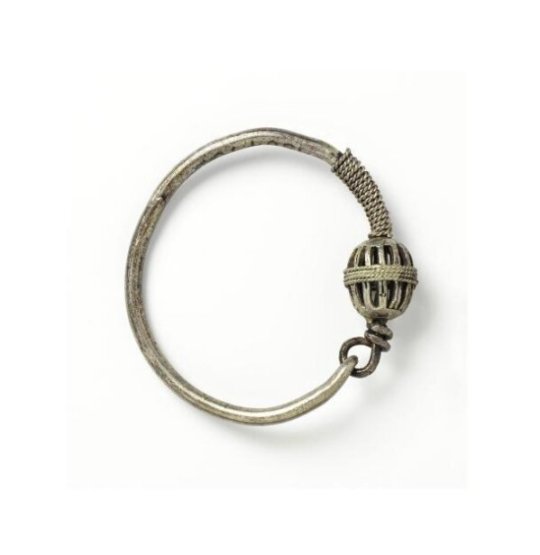
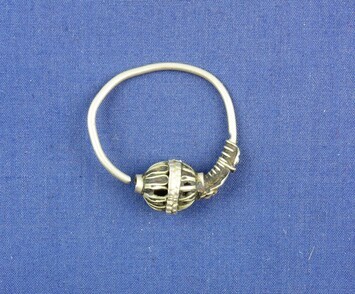
While Lane says nose rings were worn all over Egypt, the modern discussion I've found strongly associates them with Bahariya, where they are called gatar or qatrah. There, they are made of gold (usually 12 carat), with filigree and granulation filling the lower half, worn on the right side by married women. They also typically have a large flat circle of gold covering the gap where the wire goes through the nose. This is either soldered on or apart of the central wire the nose ring is built around. Occasionally a coral or glass bead is threaded into the wire that passes through the nose. They are never made of silver, as local women say silver would damage the blood vessels in the nose. They also feel that the nose ring prevents pain and headaches while worn, and when a piece has to be sent off to repair, they urge the person transporting it to hurry back.

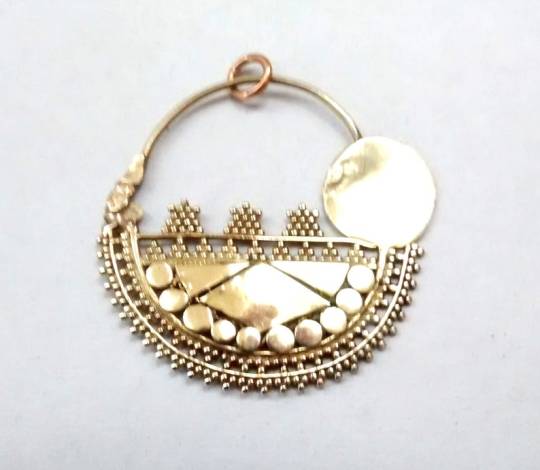
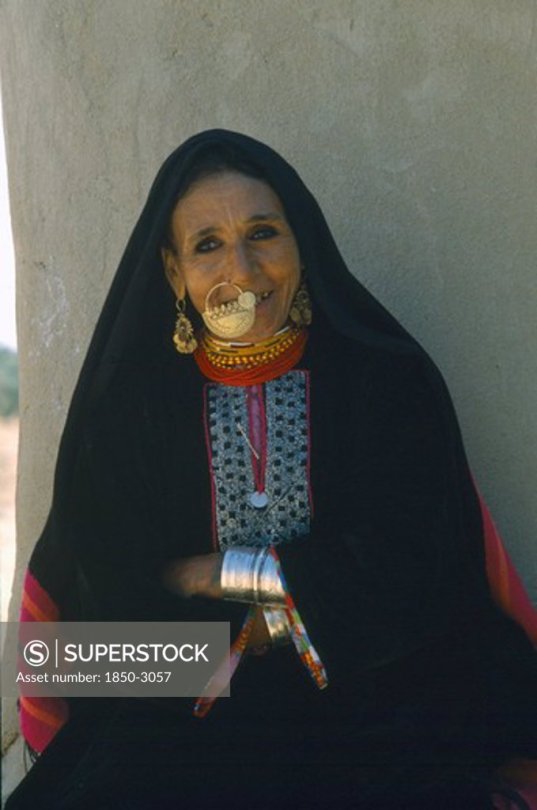
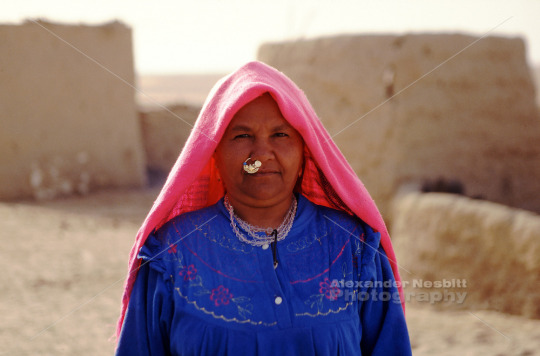
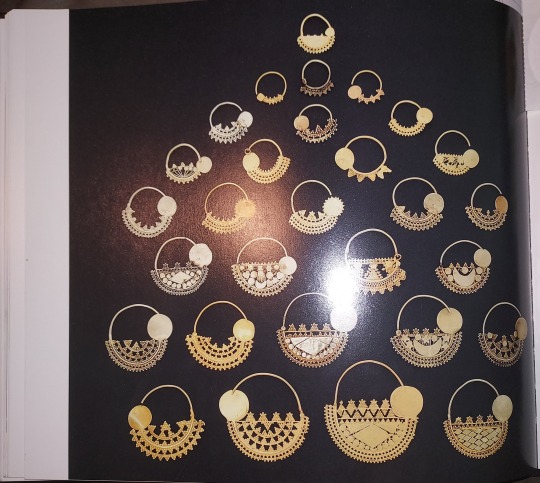
I've found some discussion of nose rings as worn by Nubians, Sinai Bedouins, and Bisharin (Beja), Ababda (who have closely intermarried with the Bisharin), and Rashayda. The name recorded as used by Nubians and Beja is zimam. I haven't seen enough examples of Nubian or Beja Egyptian nose rings to draw conclusions about common manufacture, but I do have a few examples. One piece, attributed to Egypt by the Philadelphia museum, is a sliver ring with part of the wire flattened and cut halfway through. Azza Fahmy also provides a photo, putting it under a collection of earrings from the Red Sea area. Similar nose rings can be seen in these two photos from Sudan. I have also seen a photo allegedly of an Egyptian Nubian girl with a gold nose ring that has a similar partially flattened design.
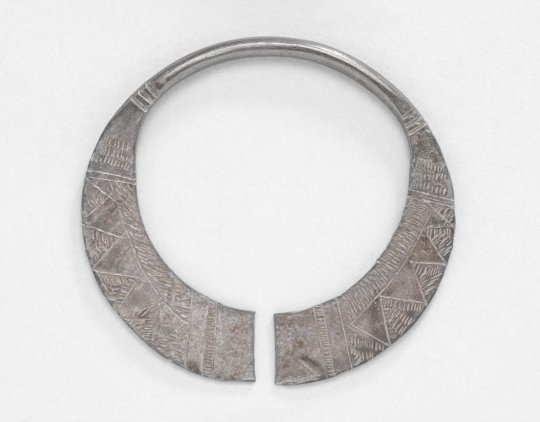
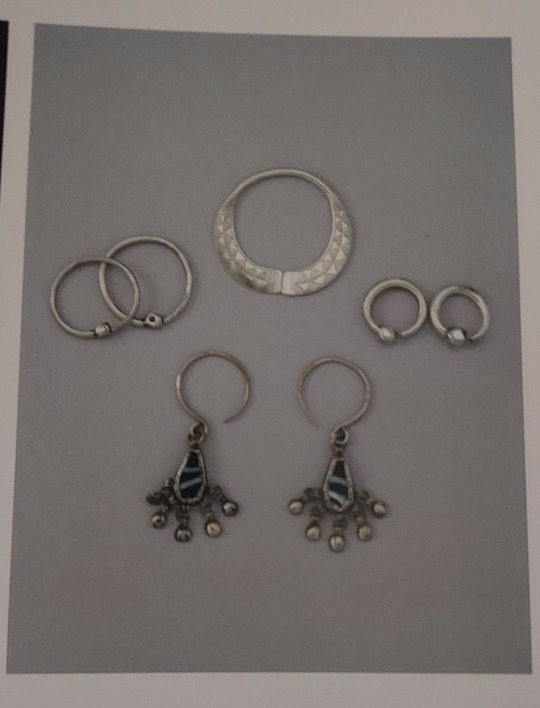
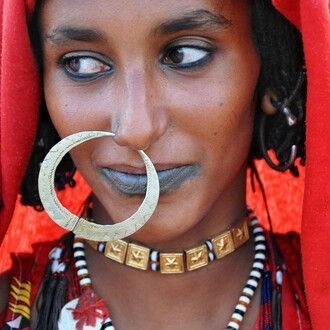
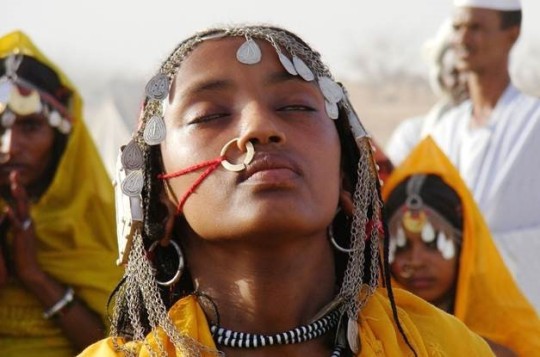
Other Sudanese nose rings I've seen are gold, with a chain leading from the ring to the hair, in a similar fashion to the nath in India. However, these are not necessarily synonymous with Nubian nose rings, as Sudan has an Arab/Arabized cultural majority. At some point I'd like to ask someone who knows more about the subject if there is a distinction between the two styles, but as of now I do not know anyone who is knowledgeable on the matter, nor do I know of any academic texts that discuss the issue.
Beja jewelry has a strong influence from Nubian and Sudanese styles, owing to the fact that they live in proximity, and that more Beja live in Sudan than Egypt. Like Nubians, the Beja are an Indigenous group. They're believed to be related to the Blemmyes and the original group referred to as Medjay in Ancient Egypt, and some ostracon exist of their languages written in the Coptic alphabet (The Nubian alphabet is related to the Coptic alphabet as well, with unique letters for certain sounds). I have little information on the Rashayda, but they call their nose ring zimam. They claim to be descended from an Arab tribe, and some information I've seen implies they've intermarried with the Beja. Two nose piercings are in use by the Beja and Rashayda; a diamond shaped one worn in the center bulb of the nose, worn by Beja women, and gold nose rings with engraved designs or strung with beads, worn by both. 21k is the preference in Nubian goldwork, and this seems to be true of these groups as well.
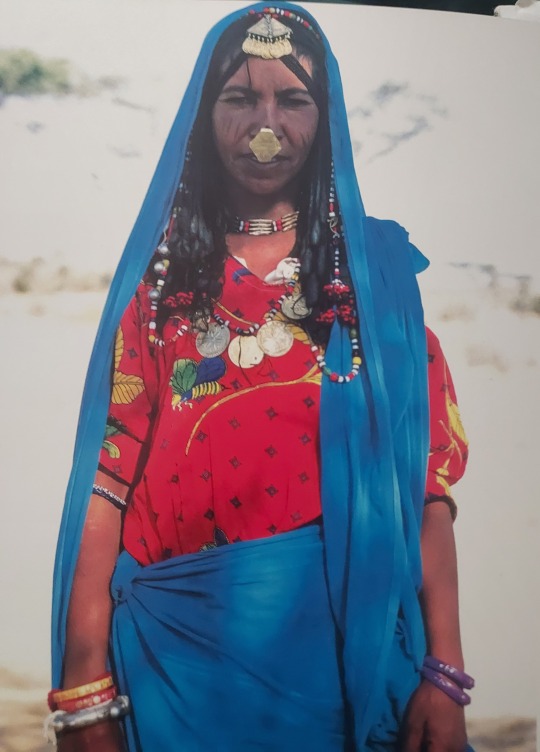
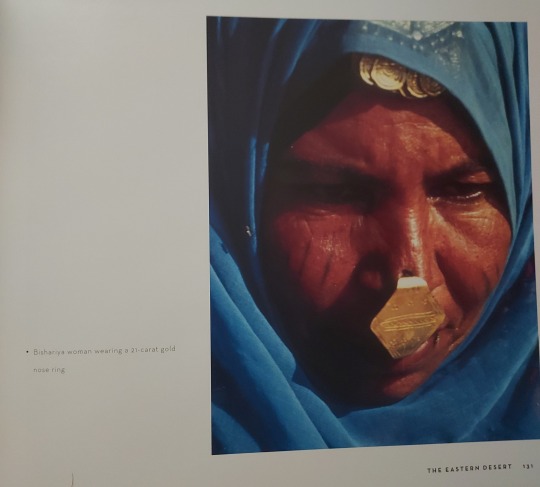
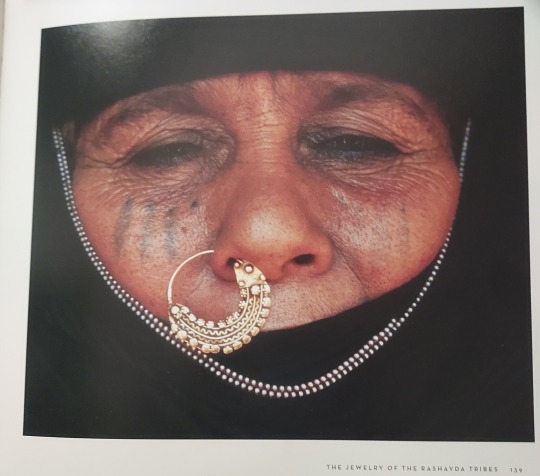
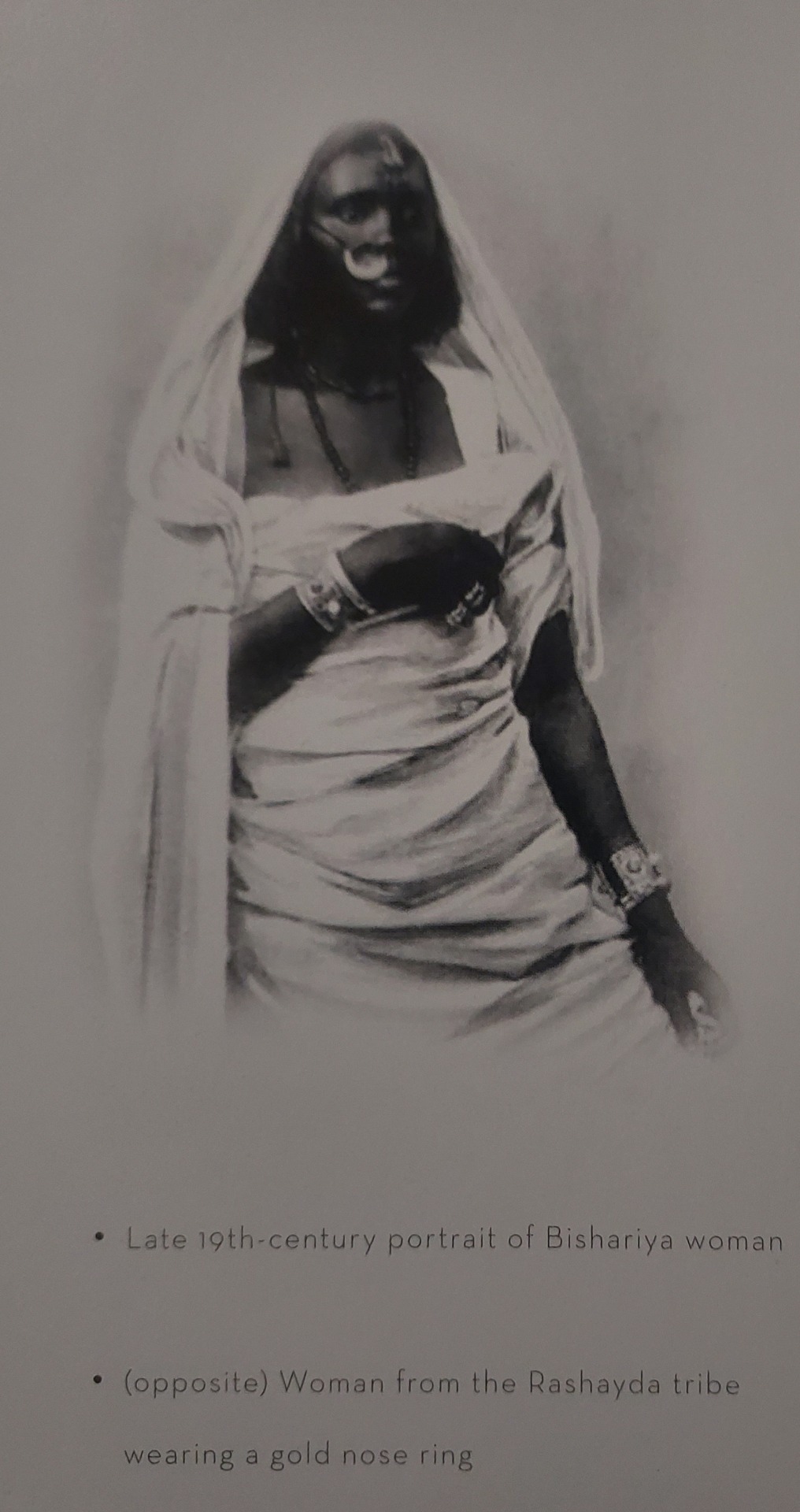
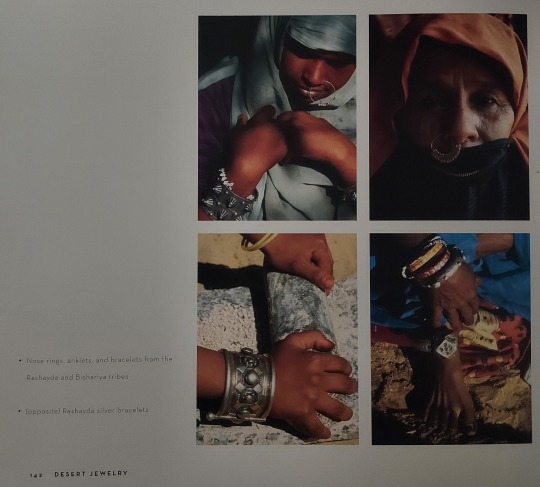
In Sinai, the nose ring is called a shenaf. It has a great deal of similarity to Palestinian nose rings, and has a similar construction to Bahariya nose rings with the lower half full of filigree and granulation. It also sometimes has beads and hanging pieces. It is most commonly made of gold.
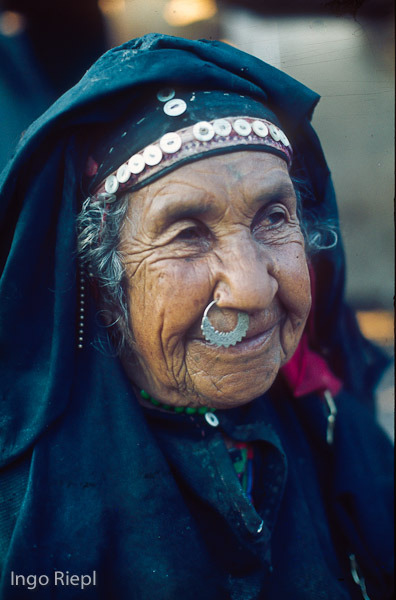


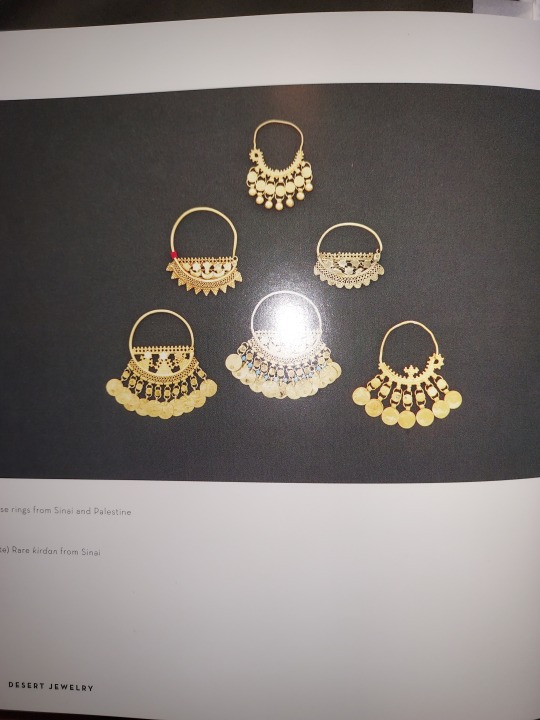
Other miscellaneous pictures of Egyptian nose rings:

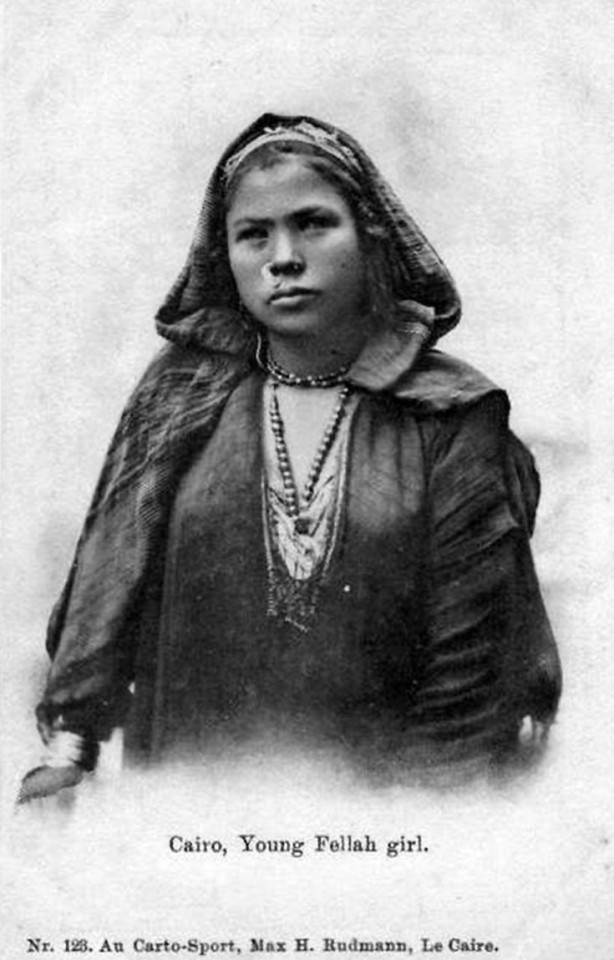
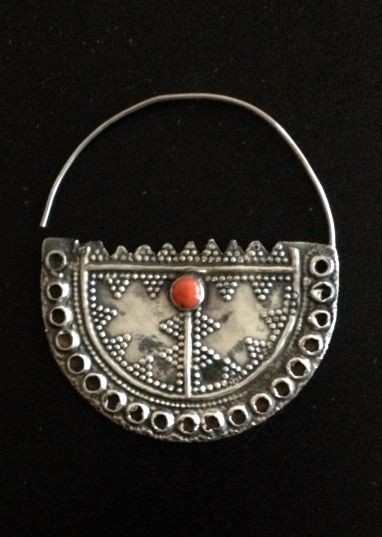
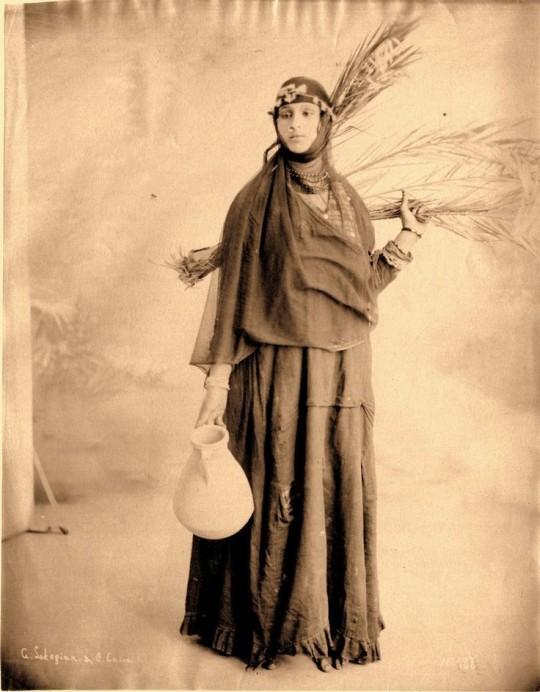
Further reading:
https://newvoices.org/2021/05/14/most-decorated-women/ https://newvoices.org/2021/05/24/i-put-a-ring-in-your-nose/ | Regarding Jewish piercings and body art
https://www.google.com/amp/s/www.dharmadispatch.in/amp/story/history/the-nose-ring-or-nath-is-an-import-from-muslim-invaders https://www.naturaldiamonds.com/style/natural-diamonds-nose-pin-history-legacy/ | regarding Indian nose rings. The first one is unfortunately incredibly biased against Muslims, and I wouldn't link it if I could find a better write up of the argument regarding nose rings being an import to India. I debated including it at all, but figured I should stick to my rule for citing biased sources in Egyptian fashion research; include it, but note the problem.
The Traditional Jewelry of Egypt by Azza Fahmy
The Manners and Customs of the Modern Egyptians by Edward William Lane
https://collections.vam.ac.uk/item/O79718/earring-unknown/
https://collections.vam.ac.uk/item/O79793/earring-unknown/
https://collections.vam.ac.uk/item/O79718/earring-unknown/
http://collections.vam.ac.uk/item/O79342/earring/earring-unknown/
https://collections.vam.ac.uk/item/O79454/earring-unknown/
https://trc-leiden.nl/collection/?trc=&zoek=saudi&cat=Accessories&subcat=&g=&s=24&f=0&id=2435
https://www.philamuseum.org/collection/object/41469
74 notes
·
View notes
Text

#polki nose pin#Polki Nose Ring#Press on Nath#press nath#press nath design#press nath design gold#press nath online#press nose nath#press wali nath#Kundan Polki Nose Pins#Women Polki Nose Pin#Latest Nose Pin#Online#Anana
0 notes
Text
So I wear this nose ring, yk???? Abhi last year ke jan mein hi I got my nose pierced so it's a patli taar wali ring
Kal didi ke saath market gai thi tab i saw SUCH pretty naths, like those traditional marathi style naths,😭😭😭😭 if this nose ring would be removable I'd buy like ten of them 😭😭 so so pretty
7 notes
·
View notes
Text

Spin of Joy: Bride in Lilac Lehenga & Groom in Navy Sherwani under a Green Pergola
A candid moment from a traditional South Asian Wedding. The bride, adorned in an intricately embroidered red and gold lehenga with heavy jewelry, including a maang tikka, nath (nose ring), and choker necklace, is seen delicately smiling while looking down. Her hands, decorated with rich henna designs, gently hold her dupatta. The groom, dressed in a cream sherwani with a matching red stole and turban, stands close beside her, partially visible. Warm golden lighting and shallow depth of field give the photo a soft, dreamy aesthetic, highlighting the couple while softly blurring the background, which features floral decor and ceremonial details. Visit: Asian Wedding Photographer in Leicester
2 notes
·
View notes
Text

Grab The Look Of Model Influencer in Full Rajputi attire and Jewellery for upcoming Rakhi, Teej and Sawan occasion
http://www.sonkanch.com
Courtesy :—
In frame : @sonam_thakur1998
Dress Designer: @poshak_by_jaishri
To shop visit our website www.sonkanch.com or walk in store or DM@9351511707
⭐Certified for gold and silver purity by leading laboratories.
⭐Guarantee on Back Silver Cover Gold Plating.
⭐100% Exchange of Full Bill Amount after 3 years
⭐️ Free Shipping All Over India
#jewellery #jewellerystore #jewelleryshop #viral #jewellerylove #handmadejewellery #designerjewellery #jewellerydesigner #stylishjewellery #indianjewelry #bollywoodjewellery #traditionaljewelry #wholesalejewelry #jewelrylovers #rajputana #rajputijewellery #royaljewels #royaljewellery #rajasthan #thewajewellery #rakhi #teej #wedding #indianbride #indianwedding #trending
#thewajewellery#thewaart#rajputijewellery#thewajewelry#jewellery#thewaartjewellerypratapgarh#silverjewelry#indianjewellery#goldjewellery#jaipur#hathfool#rakhdi#seeshfool#mathapatti#nath#nosering#nosepin#nosechain#nose jewelry#nose ring#hand jewelry#hand bracelet#handmadegift#hand accessories
0 notes
Text

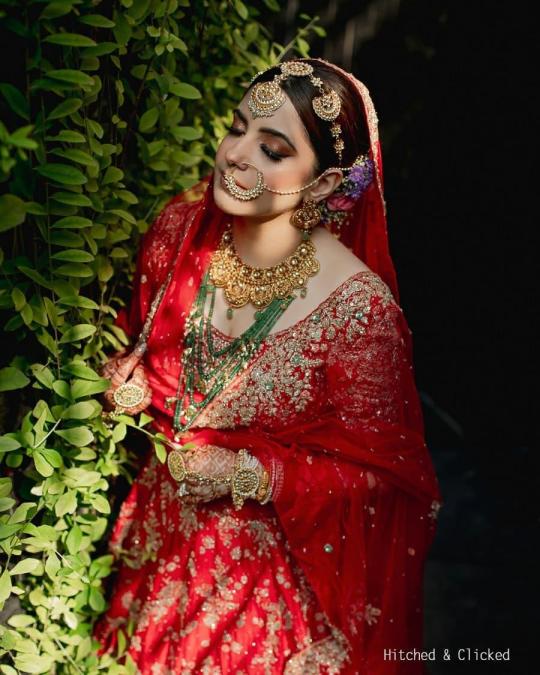
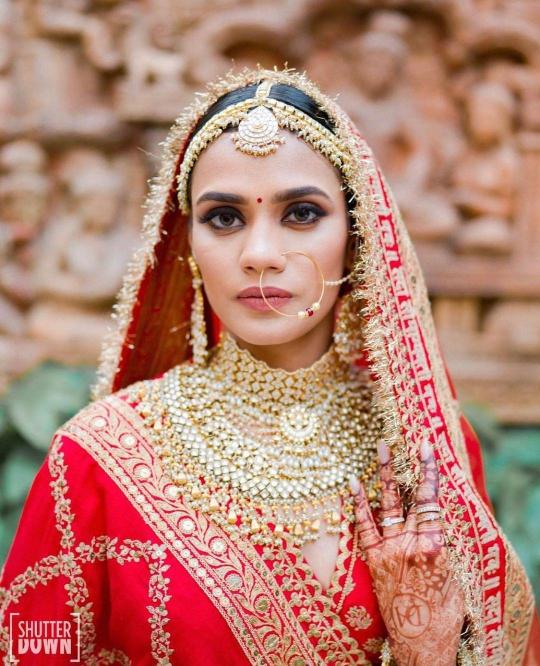
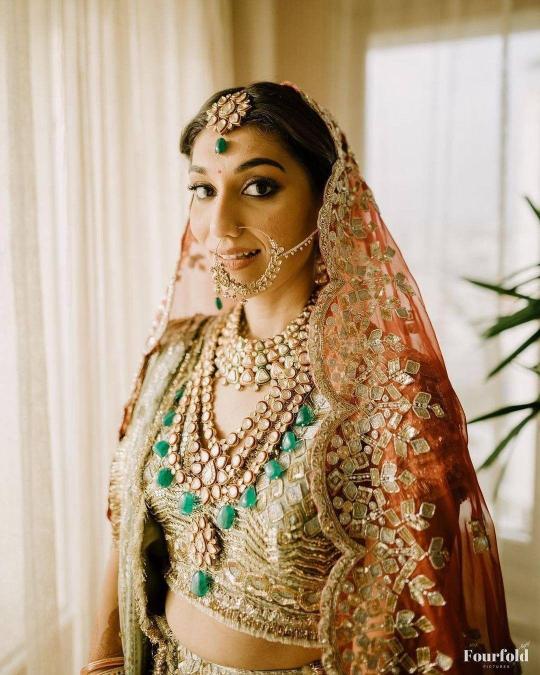
Best Nath Designs For Brides Of 2024
#best nose rings#Bridal Jewellery#Bridal Nath#bridal nose jewellery#bridal nose rings#Bridal Trousseau#Gold Jewellery#heavy bridal nath#heavy jewellery#nath designs#nose ring designs#nose rings#ott nath designs#pearl drop nath#pearl jewellery#small nath#vintage nath design#Wedding Jewellery#shaadiwish
0 notes